It is rare that my husband and I return to a House of Worship in a foreign destination for a second visit. After selecting a cruise itinerary with a stop in St. Thomas, U.S. Virgin Islands, we immediately placed The Hebrew Congregation of St. Thomas on our must-see list. Decades before digital images were in vogue, our young family trekked up the steep road to Synagogue Hill to visit this well-known synagogue with a sand floor, where we took a handful of pictures and then quickly departed with our four active sons.
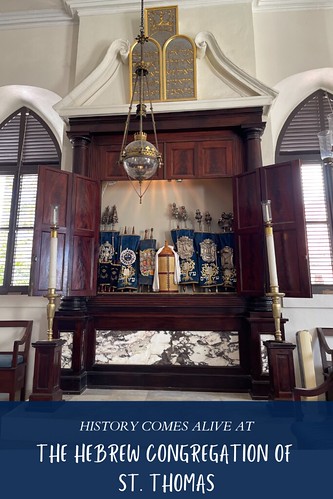
Now, we had the flexibility to hear a more complete history. We were eager to meet Agnes Rampino (Agi), a product of post Holocaust Europe, who was born in a Hungarian detention center. After growing up on the East Coast, she relocated to St. Thomas so she could start a business. As the synagogue’s historian, docent, and gift shop manager, she gladly shared the background of this unique synagogue that has the distinction of being “the oldest synagogue building in continuous use under the American flag, the second oldest in the Western Hemisphere—and only one of five synagogues in the world with sand on the floor.” The synagogue is one of a handful of National Historic Landmarks on the island.
During the mid-17th century, when the Virgin Islands were under Denmark’s rule, a small number of Jewish merchants and traders were pursing their sugarcane, molasses, and rum interests in the region. Unlike other places in the world where Jewish life was restricted, this Danish colonial society tolerated a Jewish presence. During the American Revolutionary War, Jews migrated to the Caribbean Islands to help supply arms and munitions for General George Washington’s army. Notable communities were in St. Eustatius, Surinam, Curacao, and Barbados. The Jews fleeing the British brutal attack on the Jewish community of St. Eustatius were stripped of their wealth and deported. Attempts to hide their wealth in coffins was detected. Some found their way to St. Thomas.

St. Thomas Panoramic view
Near the end of the 18th century, a small number of Sephardic Jews (Jews and their descendants who lived in Spain and Portugal before their expulsion in the 15th century) purchased land for the first St. Thomas cemetery and founded a traditional Sephardic synagogue. Economic opportunities coupled with a lack of anti-Semitism caused the community to prosper and grow.
To accommodate their spiritual needs, several synagogue structures were erected in the 19th century. These early buildings were either replaced or consumed by fire. Miraculously, the Ner Tamid (Eternal Light) and two Torah scrolls survived the devastating 1831 fire which incinerated more than a quarter of the island’s wooden businesses and homes. The current stone, brick, and mortar building dates to 1833. The walls and arched windows were designed to be fireproof and hurricane-proof.
The founding members of the congregation chose to include a sand floor to remember their Spanish and Portuguese ancestors who were forced to choose between converting to Catholicism, practicing Judaism in secrecy (Crypto Jews or Conversos), or being exiled. During the Inquisition, the New Christians who continued to practice their Judaism secretly placed sand on the floor to minimize the sounds generated from group prayer.
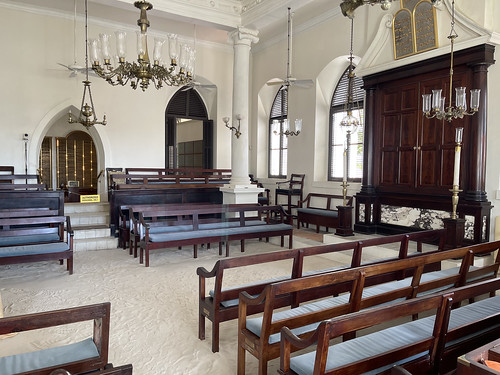
Sand on the floor at the St Thomas Jewish Sanctuary
Despite a tumultuous 19th century history, the Jewish community rebounded within a year of the fire with the help of outsiders. Agi shared some historic and notable features. A French architect designed the building. The mahogany wood on the Aron HaKodesh (Ark) and the Bimah (Platform where the Torah is chanted) were locally sourced and carved by shipbuilders. A menorah dating back to the 12th century was gifted from a Moroccan family, while the Baccarat non-electric, crystal chandeliers were donated by a French family. On Kol Nidre (the Yom Kippur evening service) and on a few other special occasions, the sanctuary is illuminated by candlelight. Italian and Central American marble accents add to the interior’s uniqueness. The columns symbolizing the four matriarchs—Sarah, Rebecca, Rachael, and Leah— were imported from Denmark and support the arched ceiling with a Star of David at the apex. These decorative white columns were strategically placed according to compass readings. Unlike an Ashkenazic synagogue, which has rows of seats (theater style) facing the Aron HaKodesh and Bimah, this synagogue follows the Sephardic style with the Bimah directly across from the Aron HaKodesh. The seating is positioned in between the structures with the rows facing one another.
When Agi opened the ark, we were surprised to see more than a couple of Torah scrolls. Instead of being made of wood, two of the scrolls have sterling silver dowels, and another scroll was inside a wooden and leather case. She singled out a special Torah on permanent loan from the Westminster Synagogue Holocaust Scroll Memorial Trust. During World War II, the Nazis confiscated Torah scrolls for a future Museum of the Extinct Race. After the Allied troops recovered this precious collection of 1,564 scrolls, these religious items were transported to London, where they were eventually distributed to worldwide synagogues. This Westminster scroll originally came from Budyne nad Ohri, a small town in the Czech Republic.
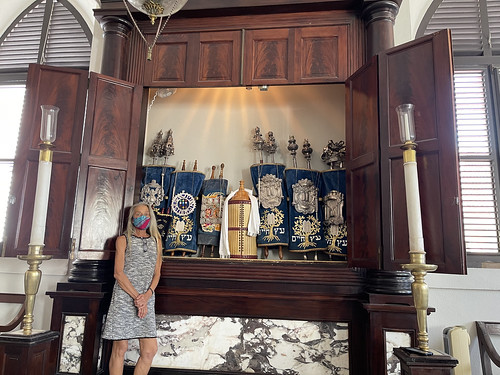
Agnes Rapino opening the Aron HaKodesh
At each B’nai mitzvah celebration, the celebrant is given the honor of holding this special Torah while walking in the sand. This unique ritual connects the Inquisition (the sand floor) and the Holocaust (the Torah scroll) with the present (the Bar or Bat Mitzvah young adult).
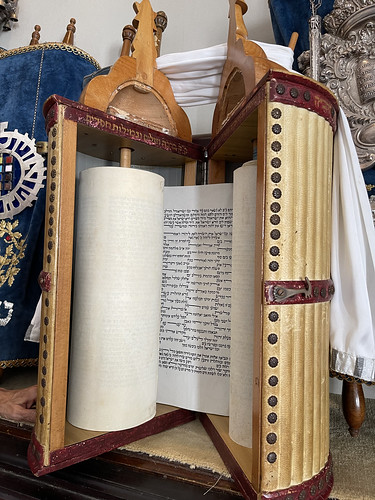
St. Thomas Torah Scroll housed in a wooden and leather case
Like many congregations around the world, the congregation’s membership has ebbed and flowed due to internal and external factors. Earlier generations were affected by philosophical differences and economic factors, as well as the influx of Ashkenazic Jews (Jews whose ancestors lived in Central and Eastern Europe) in the aftermath of World War II. Disappointingly, President Franklin Roosevelt chose to deny the Virgin Islands’ proclamation permitting Jewish refugees temporary visas to immigrate to the Virgin Islands. Lawrence W. Cramer, the governor of the U.S. Virgin Islands, and Interior Secretary Ickes supported this plan that was strongly opposed by the president and the Anti-Semitic State Department. Decades of influence from the Reform Movement introduced multiple changes, and in the 1960s the synagogue became affiliated with the Union of American Hebrew Congregations.
More recently, congregants have chosen to leave the island due to the devastating effects of tropical storms and hurricanes as well as the uncertainties generated by the pandemic. Despite fluctuations in membership, the synagogue has remained operational for over 220 years. Rabbi Michael Feshbach currently leads a congregation with around 100 families. While we had planned to meet him during our brief visit, a flat tire prevented us. With a modest number of congregants, the synagogue relies on worldwide contributions, as well as destination B’nai Mitzvah (Bar and Bat Mitzvah ceremonies) and Jewish weddings for additional revenue.
Due to a tight time schedule, we were unable to visit the synagogue’s small museum or take a drive to the historic cemetery. After our second visit to Synagogue Hill, history came alive at The Hebrew Congregation of St. Thomas.
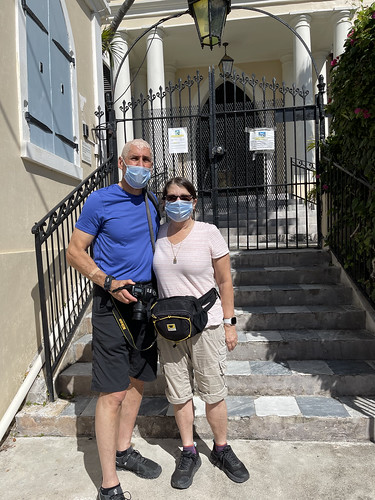
Sandy and Ira Bornstein outside historic synagogue entrance
Sandy Bornstein, the History Comes Alive Through Travel Editor for Wandering Educators, has visited more than 40 countries and lived as an international teacher in Bangalore, India. Sandy’s award-winning book, May This Be the Best Year of Your Life, is a resource for people contemplating an expat lifestyle and living outside their comfort zone. Sandy writes about Jewish culture and history, historical sites, family, intergenerational, and active midlife adventures highlighting land and water experiences.
The United States Virgin Islands Department of Tourism hosted The Traveling Bornsteins’ day tour of the island.
All photos courtesy and copyright Sandy Bornstein
